
LOOP 1 - 34 km
I beat the morning prayer up this morning - 4:45 AM, grabbed a cup of coffee, and Paula Nascimento and I drove to the venue for the 6 AM start of the 10th running of the President's Cup, more formally known as "HH The President of the United Arab Emirates Endurance Cup - the Crown Jewel of Middle East Endurance."
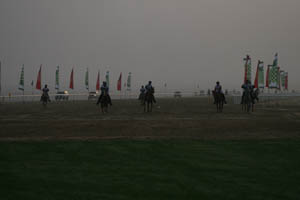 76 riders left on Loop 1 in the dark in a quite non-anarchic start. I saw one horse rearing, but nobody took off as if from a starting gate, and there was no bucking, no falling off. With some of the best horses in the UAE in the race, it would likely be another fast one: Charlandre El Sharif of Al Reef Stables, the current 160-km world record holder (6:28:28, in the 2008 Shaikh Mohammed Cup), was being ridden by Yousef Al Bloushi; Kaysand Farrazah of Al Aasfa Stables, winner of the President's Cup in 2006 and 2008, and 2nd and Best Condition in 2007 with Sheikh Majid (in 6:47:41), was being ridden by Naser Al Marzouki.
76 riders left on Loop 1 in the dark in a quite non-anarchic start. I saw one horse rearing, but nobody took off as if from a starting gate, and there was no bucking, no falling off. With some of the best horses in the UAE in the race, it would likely be another fast one: Charlandre El Sharif of Al Reef Stables, the current 160-km world record holder (6:28:28, in the 2008 Shaikh Mohammed Cup), was being ridden by Yousef Al Bloushi; Kaysand Farrazah of Al Aasfa Stables, winner of the President's Cup in 2006 and 2008, and 2nd and Best Condition in 2007 with Sheikh Majid (in 6:47:41), was being ridden by Naser Al Marzouki.
It was 55* F and damp, but no wind and no sand in the air. It only took 1 hour, 18 minutes, and 10 seconds for the first horse and rider, Omair Al Bloushi on Silversprings Kabir Arwa, to come in to the first vet gate just as the sun was appearing through the ground layer of fog/cloud. He took only 50 seconds to pulse down! Six more horses from the UAE, including Charlandre El Sharif, arrived within two minutes, all posting a 25+ km/h clip, and the rest of the field came pouring steadily in. Just 22 minutes behind the leaders came the Americans, John Crandell and Jan Worthington, along with Shaikha Madiya Hasher Al Maktoum, riding her grey stallion Solid Asa Rock. They all pulsed down in under 3 minutes. Jan was happy, "We're going right on 12 mph." To her amusement, she was stopped outside the vet gate by an interviewer with a TV camera.
Eliminated for lameness already at gate 1 were unlucky riders Rebecca Arnold of Germany, Farah Ahmed Abu Nameh of Jordan, UAE rider Saif Al Faresi, and Italian Patrizia Giacchero.
LOOP 2 - 32 km
Time to get out on course to follow the riders on loop 2, after a 30 minute hold. Brazilian journalists Cidinha and Paula, and Susanne Polzin, who single-handedly puts out Endurance Insight, Germany's only endurance magazine, jumped in my truck, and off we went. I'd thought the driving would be crazy out there on the sandy course, but it was a piece of cake.
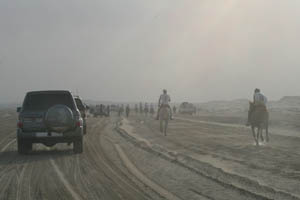 Until, that is, we actually started catching up with some riders and crews ahead (at Cidinha's insistence), and some of those crews behind started catching us. And until the sand became deeper. The driving situation rapidly deteriorated. All at once, and I don't know how this happened, there was more traffic, more horses, more dust, and deep sand. Words involuntarily started flying out of my mouth that I normally don't use. I started passing cars, some flew past me, on both sides, by inches, and I start bogging down in places.
Until, that is, we actually started catching up with some riders and crews ahead (at Cidinha's insistence), and some of those crews behind started catching us. And until the sand became deeper. The driving situation rapidly deteriorated. All at once, and I don't know how this happened, there was more traffic, more horses, more dust, and deep sand. Words involuntarily started flying out of my mouth that I normally don't use. I started passing cars, some flew past me, on both sides, by inches, and I start bogging down in places.
It didn't take long before I became stuck, on a slope SIDEWAYS, because I was in 4WD High. Everybody leaned left and held their breaths. I was able to shift to low and get us out, and from then on, I just gassed it, and kept chanting those words out of my mouth, as the sand kept grabbing the wheel out of my hands and I slid around and spun my wheels and missed cars AND people by inches. Those were the crew people who were running back to their cars after chasing their horses on foot with water bottles. Cidinha was yelling and pointing "Here! Go here! Now! Go there! Hurry! There!" and those ladies would hang out the windows Click Click Click with their cameras and I would be saying Sh*t Sh*t Sh*t because I was afraid they'd get sideswiped and knocked out of the car, or I'd slide into someone.
It occurred to me that perhaps our endurance rides in the US, where we are on our own for a 25 mile loop, no water bottles, no car support, nothing but horses and riders and scenery, make much more sense; but then, that's a different sport, where we are riding for a Tshirt completion prize, not 1,500,000 Dirhams and a Car, and nor are we riding 25 km/h, and it wouldn’t’ make much sense to these competitors. Which was why I was here right now and not in the US, to cover such a race, and why I was streaming a litany of expletives while the ladies hung on and laughed at me as I skidded around and tried to keep up and not to kill or be killed.
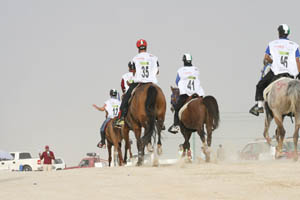 Then suddenly we came upon a pile of cars - what - were they all stuck? Wrecked? What, we were stopping here? What do I do? Keep going or stop? "Tell me before I lose my momentum!" Cidinha said "Yes park!" "Park! Where?" "Stop here!" "OK!" But I wasn't sure where exactly to stop, and I was losing my momentum and I would soon have no say in the matter, and finally, I rolled to a stop, engine revving, wheels spinning, gears grinding loudly (only because I was checking to make sure I was in low, because I was getting stuck here) ... and everybody waiting outside their cars turned to look at me. I smiled and waved, like I knew exactly what I was doing. Cidinha asked, "Have you ever driven in the sand before?" Well, come to think of it, "I don't think so!" Which made us laugh all the more, because Steph had told me, "Don't let Cidinha drive, she is crazy behind the wheel!" But then, who ISN'T crazy behind the wheel here? The sand driving is as much a part of the sport of endurance racing as is the continual dousing the horses with water, and the riding of the horses themselves.
Then suddenly we came upon a pile of cars - what - were they all stuck? Wrecked? What, we were stopping here? What do I do? Keep going or stop? "Tell me before I lose my momentum!" Cidinha said "Yes park!" "Park! Where?" "Stop here!" "OK!" But I wasn't sure where exactly to stop, and I was losing my momentum and I would soon have no say in the matter, and finally, I rolled to a stop, engine revving, wheels spinning, gears grinding loudly (only because I was checking to make sure I was in low, because I was getting stuck here) ... and everybody waiting outside their cars turned to look at me. I smiled and waved, like I knew exactly what I was doing. Cidinha asked, "Have you ever driven in the sand before?" Well, come to think of it, "I don't think so!" Which made us laugh all the more, because Steph had told me, "Don't let Cidinha drive, she is crazy behind the wheel!" But then, who ISN'T crazy behind the wheel here? The sand driving is as much a part of the sport of endurance racing as is the continual dousing the horses with water, and the riding of the horses themselves.
It turned out to be a 'water stop' - which was ironic, Susanne pointed out, since at least one car is following every rider every step of the way (except this one small portion of loop 2 right here, where only special privileged cars were allowed) and handing out water and/or running alongside the rider and pouring water on the horse. Some of the riders have a minimum of 10 cars following them at one time, as we would see later.
We stayed here and caught almost all the riders going by before heading in to the vet gate. It was warming quickly, nearing 80*F with no breeze, though fortunately, a thin film of fog/smog/haze/dust prevented the full power of the sun from beating down.
The same 8 front-runners arrived at the second vet gate within 2 minutes of each other, still averaging 25 km/h, with the leader Silversprings Kabir Arwa dropping to the 64 pulse criteria in an amazing 44 seconds.
Americans Jan and John, and Shaikha Madiya, held their positions and speed almost exactly the same as loop 1. John's mare Melika had been getting her tongue over the same bit snaffle she'd always used, and had been fighting some with him on course; they changed to a straight bit, and she was happier afterwards.
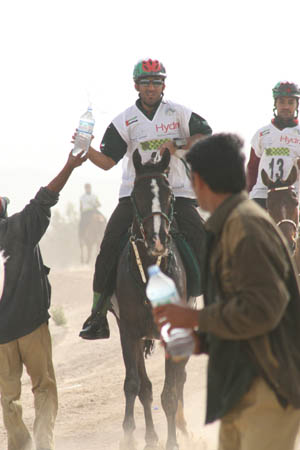 5 more riders were eliminated at gate 2 for lameness: two Indians, the lone Dutch rider, one from the UAE, and one of the Polish riders, Kamila Kart on the 2008 Polish champion, Cert. Kamila, 24, and Beata Dzikowska, 30 arrived in the UAE with their horses on February 1st. With no illusions of winning the ride, they were hopeful of a successful finish. Kamila's mare Cert is 9, and Beata's stallion Cyryl is 14. Cyryl has been doing endurance for 9 years, with two years of flat racing before that; he's already had a good career, and this was his first visit to the UAE.
5 more riders were eliminated at gate 2 for lameness: two Indians, the lone Dutch rider, one from the UAE, and one of the Polish riders, Kamila Kart on the 2008 Polish champion, Cert. Kamila, 24, and Beata Dzikowska, 30 arrived in the UAE with their horses on February 1st. With no illusions of winning the ride, they were hopeful of a successful finish. Kamila's mare Cert is 9, and Beata's stallion Cyryl is 14. Cyryl has been doing endurance for 9 years, with two years of flat racing before that; he's already had a good career, and this was his first visit to the UAE.
LOOP 3 - 30 km
By the time we returned from the course, loop 3 for the frontrunners was already underway.
We tried to grab some food, but we just missed breakfast, and lunch wasn't ready yet, and it was already time to get ready to go back out on loop 4 anyway. There never seems to be any time at these rides to get food or drink, take pictures, upload pictures, get race updates, email them out, visit with people, check on riders’ progress, etc. But, that’s endurance racing coverage. You get what you can when you can.
The same 6 riders led into vet gate 3, still maintaining a steady, torrid 25 km/h pace (15.5 mph). 8 riders were eliminated here, including Shaikha Madiya, and Portugal's Rui Periera.
Loop 4 - 24 km, Loop 5 - 24 km
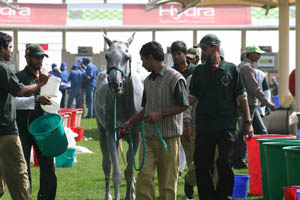 Known as 'Tora Bora,' this is the hardest loop of the ride. Now that the horses have completed 96 km and they are starting to feel a bit tired, and now that the day has warmed up from the refreshing morning chill, now they have to confront several kilometers of tough hills and deeper sand.
Known as 'Tora Bora,' this is the hardest loop of the ride. Now that the horses have completed 96 km and they are starting to feel a bit tired, and now that the day has warmed up from the refreshing morning chill, now they have to confront several kilometers of tough hills and deeper sand.
Sondar from the Dubai Equestrian Club accompanied us in the truck, and since I was a bit worried about driving with the crazies in the hills, I said "Good! If we get stuck, you can drive!" Which happened after only about the fourth hill. I never had a shot of getting through this loop! The sand was much deeper, and once I started losing my momentum going up a hill, I didn't get it back, and slowly, the little truck was sucked to a stop. Uh oh. Many cars flew by us at 100 km/h, which was probably WHY I got stuck, because I wasn't driving that fast. This is not the place to be a conservative driver, whether or not you've ever done it before. I was able to get the truck rolling in reverse, twice, but when I tried forward, it wouldn't budge. I turned the wheel over to Sondar, since I was way out of my league, and he proceeded to bury the truck's nose even further in the sand. We were truly stuck.
And so Sondar and Cidinha got on their cell phones and called for help, and meanwhile we hung around and talked and took pictures of the riders that did come by. One crew truck turned around to pull us out, but their little tow rope busted immediately, and they went on their way. A group of camel men gathered on one of the dunes to sit and watch the race and the events surrounding the stuck truck. A police jeep pulled up (many of them follow the riders) beside us, and then another one. Who was driving? they asked. Everybody pointed at me. I pointed at Sondar. We all laughed because we knew who was the pansy sand driver. The policemen let air out of our tires (I didn't know this secret!), hooked us up to a serious tow cable, and with Sondar driving, they pulled out my little truck. I let Sondar drive the rest of the way back, but then he drove on the track, so it was a piece of cake for him.
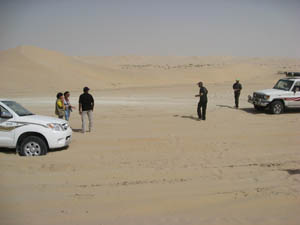 We'd missed much of everything, and just had time to grab the printed Gate 4 results before we jumped back in the truck to go out for loop 5 after the front runners. Sondar elected to stay behind at the venue this time. I wonder why!
We'd missed much of everything, and just had time to grab the printed Gate 4 results before we jumped back in the truck to go out for loop 5 after the front runners. Sondar elected to stay behind at the venue this time. I wonder why!
Well, this loop was flat, and the sand not as deep, but THE CARS, MY GOD, THE CARS!!! The cars, the dust, the crazy drivers, the insanity of it all. This really is a MotoCross Sand Sport, that has a few horses, and riders, and runners with water bottles (i.e. moving targets) mixed in. Cidinha was yelling directions and encouragement: "Go Merri! GO! THAT WAY! NOW! CROSS OVER THE TRACK HERE! FASTER!" even though I'm pretty sure she couldn't see anything more through the wall of dust than I could.
Hopefully nobody would be stopping right in front of us, or swerving right in front of us, because I was driving completely blind at some spots, there was so much dust. I successfully wove us through some of the honking speeding zooming cars, and we were getting closer to the leaders. Cidinha and Paula hung out the windows on the track side and shot away as we passed some riders. "There's Maria!" (World Champion Maria Alvarez Ponton, riding the gray gelding EO Fawati, in about 8th place). Click Click went the cameras, as I gripped the wheel in terror and held my breath and tried not to slide into cars on either side of me.
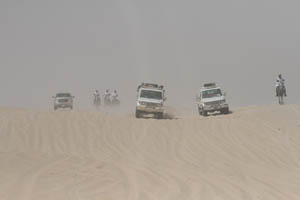 "Go Merri! There are the leaders! GO MERRI! THAT WAY!" Cidinha directed, and I zipped through some dust and racing cars, and suddenly, up ahead: an absolute WALL of cars, speeding ahead of us. Spread across what looked like a half mile of desert. I had to go WAY wide, and I was going WAY FAST, and I was hoping to God that it was not WAY DEEP sand I was hitting at warp speed, and that I wouldn't slide sideways or flip over into the next car. "OMG! OMG! OMG! OMG!" I kept chanting, between slips and bogs and slides and swipes with an inch to spare.
"Go Merri! There are the leaders! GO MERRI! THAT WAY!" Cidinha directed, and I zipped through some dust and racing cars, and suddenly, up ahead: an absolute WALL of cars, speeding ahead of us. Spread across what looked like a half mile of desert. I had to go WAY wide, and I was going WAY FAST, and I was hoping to God that it was not WAY DEEP sand I was hitting at warp speed, and that I wouldn't slide sideways or flip over into the next car. "OMG! OMG! OMG! OMG!" I kept chanting, between slips and bogs and slides and swipes with an inch to spare.
Somehow I got through the flying car barricade, (I think I closed my eyes) which was escorting the leaders, and kept going on Cidinha's wild yahooing, "YOU DID IT! YAY MERRI!!!! GO! GO!" Then the idea was to pull over somewhere so we could catch the leaders coming at us. What - stop in front of the leading riders and the 70 cars barrelling along at 90 mph towards us??? We pulled over just beyond a 'water stop' (so maybe we'd be somewhat sheltered, behind one man, his shade umbrella, small table and 2 chairs, and 6 trash cans full of water), and waited for the riders to come through. You'd think it was a hundred riders with all the cars, but no, it was only 4 riders with a wall of cars coming at us at a 24 km/h canter, the two Al Baloushis from Al Reef stables, Ali Al Muhairi on Sudan (Shaikh Hamdan Al Maktoum’s stables), and Abdullah Khamis Ali Saeed on Elphyn Phoxx (Al Reef stables). After staying with the top 7 all day, Elphyn Phoxx, who was 2nd to EO Jaras in January’s Shaikh Mohammed Cup (clocked in 6:41 for 160 km), would be eliminated at gate 5 by lameness.
After a few more riders and cars raced by, a lone rider with a big escort was bearing down on us. Just as I noticed his horse looked tired, Shaikh Hazza Al Nahyan hopped off his gray mare Ladja Lotoise, who had won a 120 km race at Bouthib in Dubai last year, and it looked like he must have decided to retire her, because one by one, his 12-car escort peeled away and turned back toward the vet gates.
We did the same, arriving just in time to see the American riders come in off Loop 4 for their 50 minute hold, averaging 17.7 km/h (10.9 mph), almost 2 hours behind the leaders. They vetted through, horses and riders looking good. Jan said of Leon: "He's the same as Malaysia, but mentally this is easier. It's wide open, and horses love to see around them. Malaysia was scary, with kids running around, yelling and screaming, bikes, things in bushes. When Leon first saw THIS place, he was like - racetrack!!! Let me go! I can run!"
John said Melika was going much more relaxed with the new bit in her mouth. Tora Bora is arguably the hardest loop, but it's like back home in Virginia to John and Melika with the hills. "It's not the heat or humidity that will take the biggest toll on a horse here," says John, "but the sand. The only way to get used to sand is to get out in it and get used to it." Most of the sand on this track is fine, smooth sand, polished like glass, very soft, unless it’s watered down and packed. It takes special muscles to travel efficiently in that kind of footing, and some horses just don't have it in them and never do adjust. I had sore muscles myself the next day from just walking in it half the day.
Australian Penny Toft and Kitt were already in from loop 4, and though Kitt passed the trot-out Penny wasn't pleased with how she'd been moving. "I didn't like how she was traveling in the deep sand on that loop. It's a shame - because she's SO full of herself." Indeed, at the represent, Kitt was pulled for lameness. 21 horses were eliminated at this gate, almost 1/3 of the remaining field. This helped move Americans Jan and John up 13 places, to 37th and 38th.
French rider Caroline Denayer had been moving up steadily during the day, from 57th, to 47th, to 40th, to 30th place on Kouleur Du Parc, when, a few kilometers out from the 4th vet gate, her mare stumbled. Riding with a loose rein, Caroline was unable to pick her up and she came off the horse, and was stepped on, slicing her wrist open pretty severely. She was covered in blood when she got to the vet gate, and was led away, rather pale-faced, to be stitched up. Her ride ended there, but she was all right by the end of the night, stitched up and wrapped up, and her horse was fine.
Loop 6 - 16 km
The first 4 leaders had already sprinted out on their final 16-km loop 6 as Americans Jan and John headed out on their 5th loop. Leading out first by 19 seconds, Omair Al Bloushi had led all the way on Silversprings Kabir Arwa, who all day had absolutely astounding recovery times in the vet gates, worth noting: 50 seconds at gate 1 (pulse of 41), 44 seconds at gate 2 (pulse of 39), 61 seconds at gate 3 (pulse of 52), 57 seconds at gate 4 (52 pulse), and 53 seconds at gate 5 (48 pulse), while maintaining speeds of over 24 to over 26 km/h each loop. Omair pretty much galloped into the in-gates, and in the time that it took for his crew to unsaddle, and splash the horse while walking to the vet gate, the horse's pulse was down and he was in the vet gate. He was like a machine, and he really looked good on the course.
Ali Al Muhairi on Sudan sprinted out next, followed 7 seconds later by Yousef Al Bloushi on Charlandre El Sharif. Yousef was always within the top 5 ('5th place' after loop 2, but only 40 seconds behind the leader), and while Charlandre El Sharif's recoveries were 'longer' - they were still always under two minutes. He also looked amazingly fresh on course.
Following in 4th, 1 minute 16 seconds later, was Naser Al Marzouki on Kaysand Farrazah. They had moved steadily up each loop in placing, from 11th to 9th to 5th to 4th, averaging over 24 and 25 km/h each loop. The finish would be among these four horses and riders, as the next out, Salem Rashed bin Ghadayer, was 11 minutes behind in fifth place; and in a 16 km sprint to the finish, there's no making up that much ground, the only chance of winning being a vet out at the finish by one of the top four.
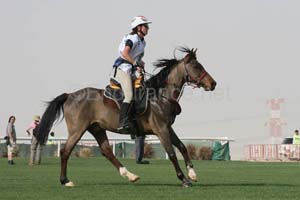 It took just 36 minutes for the herd to come in: a 5-wide, dozen-deep wall of dust and vehicles, on both sides of the straight track sprint-in to the finish, with flags waving, horns honking, guys yelling, and cannons going off, accompanying the two riders arriving at the finish together. Yousef Al Bloushi and Omair Al Bloushi (Yousef’s younger cousin) joined hands as 12-year-old South African-bred Charlandre El Sharif and Silversprings Kabir Arwa crossed the finish, with Yousef getting the 1-second nod for first. It was another astounding finish time: 6:30:53 for the 160 km - the second fastest ever. It was Yousef’s first win in the Cup, having come third twice.
It took just 36 minutes for the herd to come in: a 5-wide, dozen-deep wall of dust and vehicles, on both sides of the straight track sprint-in to the finish, with flags waving, horns honking, guys yelling, and cannons going off, accompanying the two riders arriving at the finish together. Yousef Al Bloushi and Omair Al Bloushi (Yousef’s younger cousin) joined hands as 12-year-old South African-bred Charlandre El Sharif and Silversprings Kabir Arwa crossed the finish, with Yousef getting the 1-second nod for first. It was another astounding finish time: 6:30:53 for the 160 km - the second fastest ever. It was Yousef’s first win in the Cup, having come third twice.
Coming in third 3 minutes later was Naser Al Marzouki on Australian-bred 12-year-old Kaysand Farrazah, followed 3 minutes later by Ali Al Muhairi on Australian-bred Sudan. Muhairi is the endurance and racing manager for HH Shaikh Hamdan bin Rashid al Maktoum’s stables; Muhairi and 12-year-old Australian-bred Sudan recently won the 120 km Al Wathba National Day Cup. Twenty minutes later came 5th place, Bader Al Kayoumi on the bay mare Silvina. Sixth place went to Salem Rashed bin Ghadayer on Sas Alexis - still under the 7 minute barrier. Even before the first foreign rider came in at 8th place, Maria Alvarez Ponton on EO Fawati, the awards ceremony was taking place. The three top riders received their sword prizes and the keys to their new cars, and their very enthusiastic stable crews (Al Reef, Al Reef, and Al Aasfa) joined them on the podiums.
About an hour later, the Best Conditioned judging took place with about a half dozen showing. Silversprings Kabir Arwa stood out, with a very impressive trot out, looking like he could easily continue another hundred miles. Although no formal announcement was made, which was a shame after their incredible performances, indeed later we found out that Silversprings Kabir Arwa had been named Best Conditioned. 10-year-old Silversprings Kabir Arwa, bred in New Zealand by Jenny Hearn, won last year’s 120 km Sorouh Challenge in 4:43:09 under Omair Al Bloushi, and finished 4th in this year’s 160 km Shaikh Mohammed Cup in January.
Riders continued trickling in to the finish, including the lone Saudi Arabian rider, 3 riders each from Spain and France, Alice Beet of Great Britain, Australian Meg Wade on Castlebar Kalahari, Germans Stephanie Arnold and Belinda Hitzler, and Beata Dzikowska of Poland. The Americans crossed the finish line holding hands just as it was getting dark, in 25th and 26th place, and probably the happiest person in the whole of the UAE on Saturday night was 68-year-old Jan Worthington, when Golden Lighting passed his final vet check. She was jumping up and down, hugging everybody within reach, hugging her horse, a grin on her face from here to America. Jan and John had an excellent ride time of 9:24:16 - not bad for a ride halfway around the world in an opposite season in a hundred miles of unfamiliar sand.
The lone Belgium rider, Maritza Pereira, was the last to finish on Taborah De Sier, at 7:02 PM.
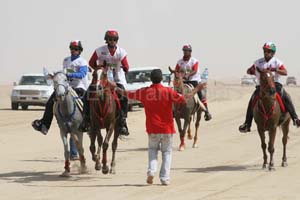 How to sum up such a ride? Jean Louis LeClerc, French chef d'equipe nailed it: "They are two different sports, endurance riding and endurance racing. We know we can't win these races."
How to sum up such a ride? Jean Louis LeClerc, French chef d'equipe nailed it: "They are two different sports, endurance riding and endurance racing. We know we can't win these races."
So why do they come, the foreign riders and foreign horses who travel halfway around the world to compete on foreign soil, when they really don't have a shot of winning?
I think it's for the experience. The riders (and maybe the crews come for the fun of the driving) who finish in the last places, 3+ hours behind the winners who set world records, are, I am pretty sure, just as happy with the performance of their horses as the winners are with their winning. They come for the experience it gives their horses, for the fun of seeing like people around the world, for riding beside an old or new friend from another part of the world, for the chance to see and learn new things, for the chance to learn a better way of riding, training, and keeping your horse comfortable and performing at his best, if it's only to learn that the same bit you've been using for 7 years may not be the optimal bit for the best performance of your horse on a given day. They come to see their horse perform at his best and do it willingly and, if not easily, then efficiently, and to see him healthy and happy the next day. That's what keeps bringing people back to the endurance races here.
It's definitely a different sport here, but so is endurance racing in and around the old city of Assisi Italy, (where this year's European championships will be held), where much of the track is over pavement and high speeds are simply not attainable; so is endurance riding over the Tevis trail, where horses who can sprout wings in sand likely wouldn't make the 19,000' of climbing and 22,000’ of descending in rugged mountainous terrain; so is the 9-day social experience of the Tierras de Al-Andalus ride in southern Spain where riders cover 50 km per day point-to-point and end each day in a quaint hotel in a historic Andalucian town; so is a fiercely individual and unique 5-day Duck XP ride in America, where you’re pretty much on your own between the starting line and finish line each day.
They are all endurance horses: the amazing horse who can win 6 Tevis Cups; the horse that can win a 9-day ride with steady trotting over sandy beaches, through olive forests and up and over a mountain range; the horse that can practically sprint for 100 miles through sand in less than 7 hours; the horse that can go 18,000 miles over his career (and Tulip in the US is still going); the backyard horse who can cover 50 miles in 10 hours every couple of months when his owner can get time off of work. They all take exceptional willing horses that excel at what they do, and make their riders very, very happy.
Any way you look at it, it's all endurance, and it’s all about the Endurance Horse.
And this ride, the 2009 President’s Cup in Abu Dhabi, was all about some incredibly fast and amazing desert endurance racehorses.
Merri




